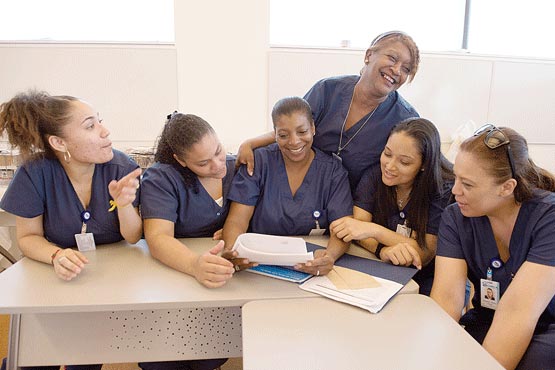Before Zaida Ramos joined Cooperative Home Care Associates, she was raising her daughter on public assistance, shuttling between dead-end office jobs, and not making ends meet. “I earned in a week what my family spent in a day,” she recalled.
After 17 years as a home health aide at Cooperative Home Care Associates (CHCA), the largest worker-owned co-op in the United States, Ramos recently celebrated her daughter’s college graduation. She’s paying half of her son’s tuition at a Catholic school, and she’s a worker-owner in a business where she enjoys flexible hours, steady earnings, health and dental insurance, plus an annual share in the profits. She’s not rich, she says, “but I’m financially independent. I belong to a union, and I have a chance to make a difference.”
Can worker-owned businesses lift families out of poverty? “They did mine,” Ramos said. Should other low-income New Yorkers get involved in co-ops? She says, “Go for it.”
New York City is going—in a big way—for worker-owned cooperatives. Inspired by the model of CHCA and prodded by a new network of co-op members and enthusiasts, Mayor Bill de Blasio and the New York City Council allocated $1.2 million to support worker cooperatives in 2015’s budget. According to the Democracy at Work Institute, New York’s investment in co-ops is the largest by any US city government to date.
Cooperatives are businesses owned and controlled by their members on the basis of one member, one vote. Given enough time, worker-owned cooperatives tend to increase wages and improve working conditions, and advocates say a local co-op generally stays where it’s founded and acts as a leadership-building force.
“There is no greater medicine for apathy and feelings of living on the edges of society than to see your own work and your voice make a difference,” says a report on co-ops by the Federation of Protestant Welfare Agencies in New York.
Selling the Council on Co-ops
This January, as a new mayor (who ran on combating inequality) and a progressive majority of the City Council were taking office, the Federation’s report inspired Councilmember Maria Del Carmen Arroyo to think about co‑ops. “A bulb went off,” she said.
Arroyo, incoming chair of the Community Development Committee, represents a South Bronx district that’s still one of the poorest in the nation, even after years of “development.” National retailers, attracted by tax breaks, typically pay low wages and squeeze out local businesses. Partly in response, the Bronx is also home to an array of co‑ops, from the large CHCA to the small Green Worker Cooperatives, which incubates local green businesses.
When Arroyo convened a first-of-its-kind hearing on co-ops this February, New Yorkers packed not one but two hearing rooms at City Hall.
Among the co-op members who testified was Yadira Fragoso, whose wages rose to $25 an hour—up from $6.25—after becoming a worker-owner at Si Se Puede, a cleaning co-op incubated by the Brooklyn-based Center for Family Life. Translation at the hearing was provided by Caracol, an interpreters’ cooperative mentored by Green Worker Cooperatives.
By spreading risk and pooling resources, co-ops offer people with little individual wealth a way to start their own businesses and build assets. That said, if starting and sustaining a successful cooperative business were easy, there would probably be more of them.
As of January 2014, just 23 worker-owned co-ops existed in New York, of which only CHCA employed more than 70 people. Nationwide, according to data from the US Federation of Worker Cooperatives, roughly 300 worker-owned cooperatives average 11 workers each. Lack of public awareness and funding, as well as a weak support system, holds co-ops back, researchers say, and cumbersome city paperwork doesn’t help.
 New graduates from a free training program in July at the Cooperative Home Care Associates offices in the Bronx, N.Y. (Photo: Stephanie Keith)
New graduates from a free training program in July at the Cooperative Home Care Associates offices in the Bronx, N.Y. (Photo: Stephanie Keith)
A Working Model
CHCA is over 90 percent owned by women of color and yet (because of the co-op’s many owners) it hasn’t qualified as a minority- and women-owned business, Arroyo told the hearing. (Such businesses enjoy privileges in bidding for contracts.) “There’s no earthly reason we can’t change that,” Arroyo said.
If they are to change anyone’s life for the better, though, co-ops have to be successful businesses, and that’s hard, says Michael Elsas, CEO of CHCA.
The co-op was founded in 1985 on the premise that if workers owned their own company they could maximize their wages and benefits, and if workers were better trained and better treated, they’d offer better care to their clients. Creating the worker co-op was the first step. But to truly change life for their workers in a race-to-the-bottom industry such as health care, the founders knew they’d have to change the industry.
To that end, CHCA worked on several connected tracks. To raise industry standards, not just for CHCA workers but across the field, CHCA started the worker-run Paraprofessional Healthcare Institute (PHI) that trains agencies across the country while also fighting for policy shifts. (PHI was instrumental in the campaign that recently expanded the Fair Labor Standards Act.)
To better address the needs of home care clients, in 2000 they created Independence Care System (ICS), a multibillion-dollar managed-care company, which contracts with the city to work with chronically sick and disabled adults. With ICS, CHCA filled an unmet need while also creating its own primary customer to fuel the co-op’s growth. ICS is responsible for 60 percent of CHCA’s business, and the co-op has grown from 500 workers in the late 1990s to 2,300 today.
Workers become “owners” with a buy-in of $1,000, paid over time. Of today’s 2,300, some 1,100 are worker-owners, Elsas says. The company had $64 million in revenues in 2013. They’ve raised wages, but more important to workers like Ramos are the regular hours, the family health insurance, and membership in the Service Employees International Union Local 1199. In short, respect.
CHCA occupies two floors of a new office building on Fordham Road. Peer-mentors answer caregivers’ calls at desks, with plenty of cushioned sitting-room space for talking. In the PHI training lab, there are no model plastic dummies. Workers in training learn what it’s like to be both caretaker and patient.
Wages for CHCA’s health care workers stand at $16 an hour including benefits, Elsas says. It’s not affluence, but it’s still almost twice market rate. Workers enjoy guaranteed hours—an average of 36 a week, compared to an industry norm of 25 to 30. They’re paid for business meetings, and in a state where the CEO-to-minimum-wage-worker pay ratio stands at 405: 1, the ratio at CHCA hit its highest (11:1) in 2006. Turnover stands at 15 percent, compared with an industry standard close to four times that.
“If I didn’t like it here, I wouldn’t have stayed all these years,” Ramos says.
Asked about New York’s new co-ops, CHCA’s Elsas hesitates. He’s all for making it easier for co-ops to get contracts, but he’s concerned about scale.
“I’m just not sure that setting up 26 new small co-ops will help change policy or practice,” he says.
Helen Rosenthal was changed by a small co-op: Her mother started one of the first nursery co-ops in Detroit, and she saw how lives improved. Now she chairs the New York City Council’s powerful Committee on Contracts, where she’s helping push the co-op legislation. “With co-ops, democracy is built into the legal DNA,” she said.
Administered by the Federation of Protestant Welfare Agencies (FPWA), the city’s new funds will go to 10 nonprofits (among them, Green Worker Cooperatives and the Center for Family Life). The groups must create “234 jobs in worker cooperative businesses, reach 920 cooperative entrepreneurs, provide for the start up of 28 new worker cooperative small businesses, and [assist] another 20 existing co-ops.”
With so few co-ops in existence, creating more is better, says Hilary Abell, author of a new study from the Democracy Collaborative titled “Pathways to Scale.” More is better. Co-ops thrive in a mutually supportive ecosystem. “But the biggest need right now is certainly for larger businesses, capable of hiring 100 workers and up,” she says, adding that start-ups may not be the best path to scale: “There are 200,000 small businesses in the US today, employing half of all America’s workers. Most have no succession plan.” Might some be ripe, she asks, for takeover by their workers?
After 92 years of the Federation’s fight against poverty, its leaders are clear: “Making sure that a safety net exists is not enough to help New Yorkers have satisfying lives. We needed a new approach to workforce development that would not only reduce poverty but also promote upward mobility, and that’s where co-ops can be an anchor,” says Wayne Ho, FPWA’s chief program and policy officer.
Funding for supportive nonprofits is not the only thing co-ops need from cities. In Spain, Northern Italy, Quebec, and France, robust worker co-ops benefit from laws that help co-ops access capital and public contracts. In New York, even as public dollars flow to big businesses as incentives, public spending is on the chopping block. The first city-sponsored trainings with a new, cooperative-inclusive curriculum started this summer, but passing co-op-friendly laws is going to take political power—of the sort that elected today’s progressive city leadership.
This $1.2 million won’t end poverty, but it’s a step in the right direction, says Christopher Michael of the New York City Network of Worker Cooperatives. “We have all the raw ingredients of a successful policy initiative: engaged groups, a bit of a track record and support in the city council…
“This is just a start.”
Join us in defending the truth before it’s too late
The future of independent journalism is uncertain, and the consequences of losing it are too grave to ignore. We have hours left to raise the $12,0000 still needed to ensure Truthout remains safe, strong, and free. Every dollar raised goes directly toward the costs of producing news you can trust.
Please give what you can — because by supporting us with a tax-deductible donation, you’re not just preserving a source of news, you’re helping to safeguard what’s left of our democracy.
